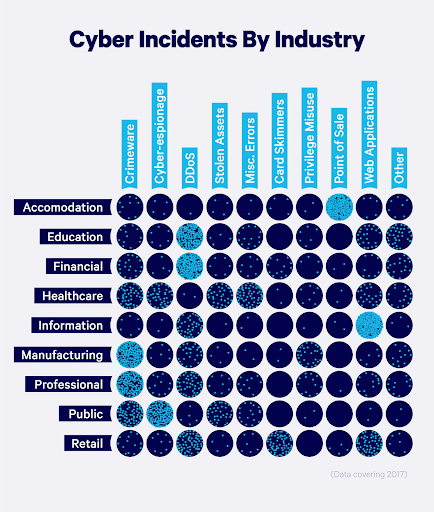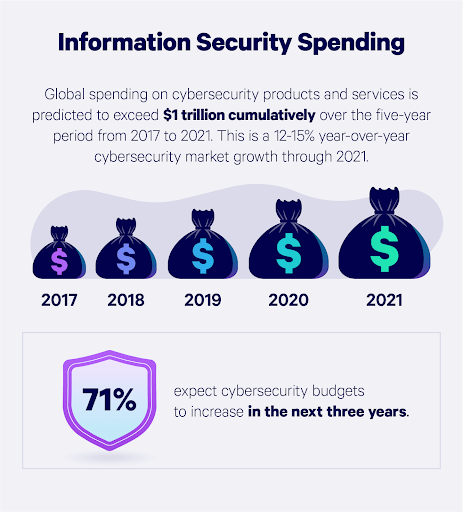Here are the top cyber security trends that we expect to see across 2022, giving readers some insight into what the future of the industry may look like.
To start off, it should be noted that much of what we expect 2022 to be has been, in some part, affected by the covid pandemic throughout 2020 and even 2021. While we may not be fully out of the woods yet, things have been quieter over the past few months. There’s the slowly growing concern about the new Omicron variant, but that’s business for another day. The point I’m trying to make is that due to 2020 popularizing a lot of digital trends, such as working from home, mass mobile gaming, and an increased reliance on online purchases, the future we look at now may reflect those very changes in the general populace’s mindset. It’s interesting to see just how much major events can lead to entire outlooks and practices being changed in a much more permanent method than we ever expect.
2022, much like it’s preceding year, is projected to have a continuing incline in malware cybersecurity threats, with ransomware being a particularly expected form of them. Ransomware, for the unaware, is a form of malware that encrypts key apps and components on one’s tech devices. Following this, the attacker will contact the afflicted individual and ask for a sum of money or some other monetary gain in exchange for unlocking the device’s contents for them. Ransomware wasn’t encountered all too much back in the day, but owing to malware kits being sold, some of them rather easily accessible as well, there are more attacks of this nature to be potentially encountered in 2022.
Another form of cybersecurity threat that users can expect to see more of in 2022 is the rise of attacks via the Internet of Things (IoT). The IoT refers to more and more basic electronic devices and appliances being connected to each other via Bluetooth or the internet. When even one’s fridge can be remotely accessed from a mobile phone, cybercriminals are provided with more access points than they know what to do with. The result is that even access to one’s kettle can then lead to sensitive information on laptops or mobiles being fully exposed. While attacks via the IoT are already encountered, 2022 will most probably see a rise in not only individual threats but also the further sophistication of their delivery methods.
Due to this rampant rise in cybersecurity threats, businesses are also projected to change their activity in order to adjust; specifically, they will be more selective in who they partner with. When so many separate venues can be used in order to access sensitive information (which is more often than not online), businesses large and small will no longer be able to afford big risks. Everyone will need to adhere to best practices in terms of cybersecurity if they want to stay relevant and afloat.
However, with all of these threats, there will be a rise in preventative measures as well. 2022 is the year that we’ll be seeing a rise in AI-based cybersecurity, with the technology becoming more and more sophisticated as machine learning develops to prevent all sorts of conducted attacks. Sure, hackers are getting smarter, but so are the figurative guardsmen. Finally, we can expect to see a rise in regulation, with more bodies and rules being established in the interest of pinning down and punishing cybercriminals both large and small. Take a look at below infographics and charts from Embroker for more insights.
Read next: AV-TEST Published Its Findings On The Best macOS Anti-Virus Software, With Separate Lists For Home And Business Users
To start off, it should be noted that much of what we expect 2022 to be has been, in some part, affected by the covid pandemic throughout 2020 and even 2021. While we may not be fully out of the woods yet, things have been quieter over the past few months. There’s the slowly growing concern about the new Omicron variant, but that’s business for another day. The point I’m trying to make is that due to 2020 popularizing a lot of digital trends, such as working from home, mass mobile gaming, and an increased reliance on online purchases, the future we look at now may reflect those very changes in the general populace’s mindset. It’s interesting to see just how much major events can lead to entire outlooks and practices being changed in a much more permanent method than we ever expect.
2022, much like it’s preceding year, is projected to have a continuing incline in malware cybersecurity threats, with ransomware being a particularly expected form of them. Ransomware, for the unaware, is a form of malware that encrypts key apps and components on one’s tech devices. Following this, the attacker will contact the afflicted individual and ask for a sum of money or some other monetary gain in exchange for unlocking the device’s contents for them. Ransomware wasn’t encountered all too much back in the day, but owing to malware kits being sold, some of them rather easily accessible as well, there are more attacks of this nature to be potentially encountered in 2022.
Another form of cybersecurity threat that users can expect to see more of in 2022 is the rise of attacks via the Internet of Things (IoT). The IoT refers to more and more basic electronic devices and appliances being connected to each other via Bluetooth or the internet. When even one’s fridge can be remotely accessed from a mobile phone, cybercriminals are provided with more access points than they know what to do with. The result is that even access to one’s kettle can then lead to sensitive information on laptops or mobiles being fully exposed. While attacks via the IoT are already encountered, 2022 will most probably see a rise in not only individual threats but also the further sophistication of their delivery methods.
Due to this rampant rise in cybersecurity threats, businesses are also projected to change their activity in order to adjust; specifically, they will be more selective in who they partner with. When so many separate venues can be used in order to access sensitive information (which is more often than not online), businesses large and small will no longer be able to afford big risks. Everyone will need to adhere to best practices in terms of cybersecurity if they want to stay relevant and afloat.
However, with all of these threats, there will be a rise in preventative measures as well. 2022 is the year that we’ll be seeing a rise in AI-based cybersecurity, with the technology becoming more and more sophisticated as machine learning develops to prevent all sorts of conducted attacks. Sure, hackers are getting smarter, but so are the figurative guardsmen. Finally, we can expect to see a rise in regulation, with more bodies and rules being established in the interest of pinning down and punishing cybercriminals both large and small. Take a look at below infographics and charts from Embroker for more insights.
Read next: AV-TEST Published Its Findings On The Best macOS Anti-Virus Software, With Separate Lists For Home And Business Users






